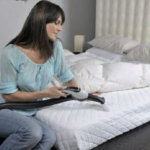Laying a parquet board is quite simple, it has large sizes and this is its main advantage, since the cost of laying time is minimal. It can be laid in the same way as an ordinary parquet, it is worth it over the entire area, especially for a multi -layer board. A massive parquet board can be fixed to the floor with nails or simply put on the lags.
An ideal option for laying the floor is the Haro Parquet board, which is produced by a German manufacturer. It is saturated with special compounds that help maintain its original appearance and protect the board from damage. In addition, these boards are moisture resistant and fit perfectly to the floor surface. The manufacturing technology itself provides for the use of three layers of wood.
Methods of laying
The optimal way of laying is a “floating” method, it does not provide for gluing the board to the base, but only to each other with the help of locks, which are smeared with glue in some cases. Modern technologies include the use of locks when laying products of Haro. Actions are performed the simplest, but the coating is connected reliably. The manufacturer specially created crests and grooves, which, in fact, form locks, they quickly and reliably connect the boards with each other. The connection does not lose its strength over time, and also does not depend on the temperature difference or humidity in the room where the parquet is laid, with load it also feels perfect.
After the board is laid, it is covered with varnish and profiled. So the surface acquires the form of a single whole, individual boards are not visible on it.
The fastening involves the operational replacement of a certain board or dismantling, which is carried out very simply and the coating can be replaced by a new. To achieve the stiffness of the base of the board, it is best to plant on the adhesive base, the “floating” method in this situation is not the best solution. Before gluing a parquet board, the base should be leveled, cleaned and well dried, it should also not contain the remnants of dust and dirt.
For a substrate for parquet, you can use various materials. This can be a sheet of plywood, but it is best to choose a birch, the thickness of which should be at least twelve millimeters or chipboard with a thickness of nineteen millimeters, a cork substrate, which is covered on the base with a continuous layer, and it will additionally play a soundproof role. In addition, foamed polyethylene is suitable for these purposes.
During styling, it is worth adhering to one rule, which provides for the exclusion of a complete fit against the walls or other fixed structures. This is done to create a temperature gap when the parquet expands near all thresholds or doors, heating pipes, columns, stairs, or simply in the area of adjacent coating from another material. The gap should be at least one and a half millimeters per meter of floor width.
Advantages of the coating
Parquet is made of a wide variety of wood, which has various color solutions and advanced methods of laying it on the floor, due to this, the parquet board successfully competes in the market of floor materials. When leaving, the parquet does not require much effort, it is easy to restore and can be varnished, and the material itself is environmentally friendly and has an attractive appearance. Therefore, if you only choose a coating for your home, opt for products from the company Haro.







